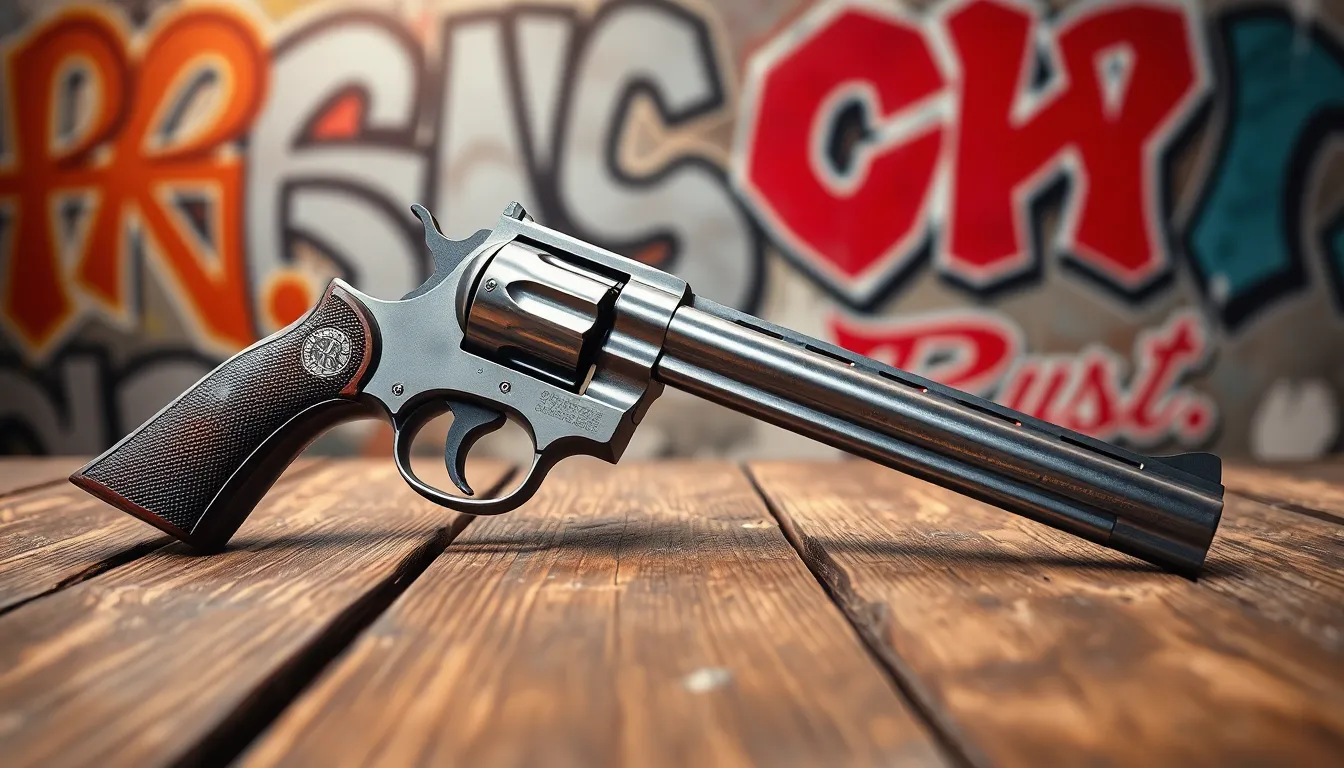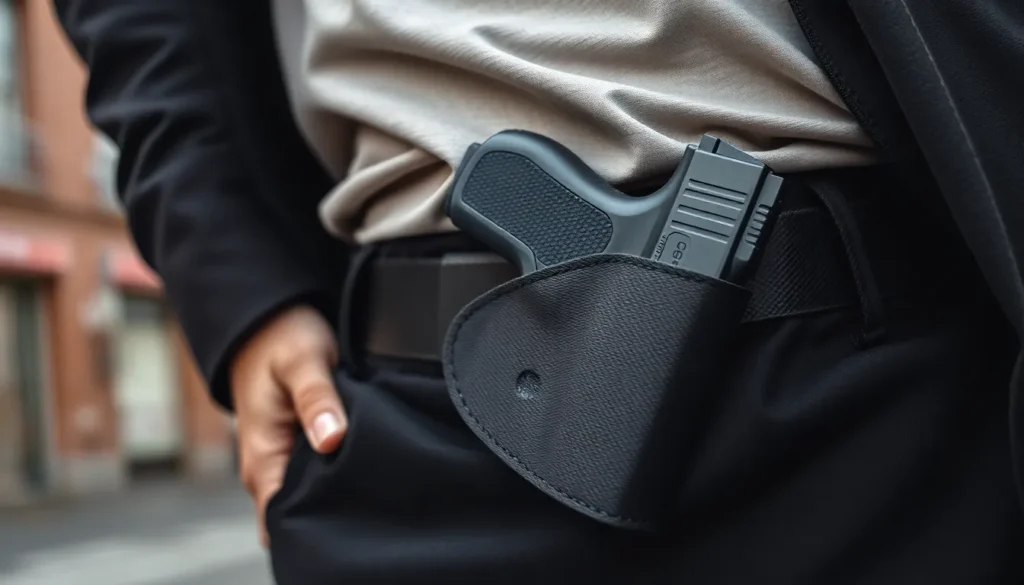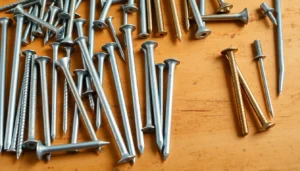Ever heard someone mention a “roscoe” and wondered if they were talking about a new dance move or a trendy snack? Well, think again! In the world of slang, a roscoe refers to a concealed firearm, often tucked away in a waistband for easy access. It’s a term that’s both intriguing and a bit cheeky, reflecting a certain street-smart flair.
Table of Contents
ToggleOverview of Roscoe in a Waistband
The term “roscoe” commonly denotes a concealed firearm, specifically stored in a waistband for accessible use. Derived from street culture, this slang term carries an air of bravado. Individuals often rely on waistbands for discreet carrying of weapons, providing both ease of access and concealment.
Concealment techniques vary. Many prefer inside-the-waistband (IWB) holsters for comfort and security. The popularity of this method stems from its effectiveness in keeping firearms hidden while ensuring quick retrieval. A roscoe can mean different things in different communities, but the core idea remains the same: an easily accessible firearm.
Cultural references often highlight the roscoe’s significance. Songs and films depict the term, cementing its place in urban language. Such representations contribute to its allure and mystique. Those familiar with this terminology usually understand its implications within discussions of personal safety and self-defense.
Size and type of the firearm also matter. Compact models often fit better in waistbands, enhancing comfort and concealment. This practicality leads many to choose smaller calibers that offer reliability without adding bulk. Typical choices include subcompact pistols, which strike a balance between firepower and portability.
Maintaining safety is crucial. Individuals carrying a roscoe must prioritize proper training and knowledge about local laws. Legal restrictions may dictate carrying methods and firearm types. Awareness of these regulations ensures responsible ownership and handling.
Historical Context

The term “roscoe” has cultural roots embedded in urban slang and street language. Originating in the early 20th century, its exact beginnings are somewhat unclear, yet it is often associated with the term “Roscoe” used in literature and music to refer to firearms.
Origin of the Term
Slang dictionaries trace “roscoe” back to the 1920s, primarily used in American gangster culture. By the mid-20th century, its connection to handguns solidified, emerging as a shorthand for a concealed weapon. Some sources suggest the term links back to a specific brand of revolver, while others believe it originated from a popular song or a notable criminal figure. Cultural density surrounding this term showcases its resilience and adaptability in urban vernacular.
Evolution of Use
Over decades, the usage of “roscoe” expanded within various communities. In the 1980s, hip-hop music propelled the term into mainstream consciousness, emphasizing a narrative of survival and empowerment. As media, particularly films and songs, depicted characters utilizing a roscoe in their narratives, its meaning began encompassing themes of both protection and danger. Presently, the term remains relevant, oftentimes embodying the street-smart essence tied to firearm carry culture while retaining its original cheekiness.
Functionality and Design
The functionality and design of a roscoe in a waistband cater to efficient, discreet carrying of firearms. Accessibility ranks as a top priority, allowing for quick retrieval in high-pressure situations.
Types of Roscoes
Various types of roscoes exist, each serving specific purposes. Compact models often include subcompact handguns, designed for easy concealment. Revolvers also qualify, offering reliability and simplicity, while semi-automatics provide rapid-fire capability. Options vary from brands like Glock and Sig Sauer to smaller revolvers from manufacturers like Smith & Wesson. Preferences differ based on user comfort, local regulations, and intended use.
Materials Used
Materials impact both the firearm’s weight and durability. Common options include polymer, often used in frames for its lightweight characteristics. Steel remains popular for barrels and slides, providing strength and longevity. Aluminum incorporates itself into compact models, balancing weight and resilience. Choices in materials affect comfort during carrying and ease of concealment. Many users select firearms with finishes that resist corrosion and wear, ensuring longevity in varied environments.
Practical Applications
Carrying a roscoe in a waistband serves various practical purposes. Individuals favor this method for its convenience and immediacy.
Everyday Carry
Everyday carry situations often require concealed firearms for protection. The ease of access offered by inside-the-waistband holsters makes them popular among users. Compact firearms like subcompact handguns work well in such setups. These models ensure comfort while remaining discreet. Many people choose lightweight designs to enhance mobility. Reduced weight allows for extended wear without discomfort. Ultimately, the choice of firearm depends on personal preferences and local regulations.
Safety Considerations
Safety plays a crucial role in carrying a roscoe in a waistband. Proper training ensures responsible handling and storage. Users must understand local laws governing firearm ownership for compliance. Regular practice enhances confidence and proficiency in retrieving the firearm. Additionally, using holsters with retention features promotes safe carrying. These mechanisms help prevent accidental discharge or unauthorized access. Maintenance of the firearm is essential for reliable operation. Regular inspections support awareness of any wear or malfunctions. By prioritizing safety, individuals can carry responsibly and effectively.
Legal Implications
Carrying a roscoe in a waistband comes with significant legal considerations. Understanding the regulations surrounding concealed firearms is essential for responsible ownership.
Regulations by Region
Laws governing concealed carry vary widely across jurisdictions. Some states require permits, while others allow open carry without a license. Specific localities may impose restrictions on the type of firearm that can be carried, influencing choices for those using a roscoe. Familiarity with these regulations ensures compliance and promotes safe practices. Several states mandate training courses before issuing permits, which fosters a culture of responsible firearm handling. Failure to adhere to state and local laws could result in severe penalties, including fines or imprisonment.
Responsible Ownership
Practicing responsible ownership involves understanding both legal obligations and safety measures. Training plays a crucial role in developing proficiency in handling a roscoe effectively. Owners should regularly inspect their firearms, ensuring that they remain in operational condition. Choosing the right holster can significantly enhance safety by preventing unintended discharges. Many states require safe storage practices when not in use, emphasizing the importance of accountability. Awareness of community laws further promotes a safe environment for all individuals involved. Prioritizing education and clear communication about firearms helps cultivate a responsible culture around concealed carry.
Understanding what a roscoe in a waistband signifies reveals much about urban culture and the practicalities of concealed carry. This term encapsulates not just a method of firearm storage but also a mindset rooted in accessibility and readiness. As the landscape of firearm ownership evolves it remains crucial for individuals to prioritize responsible practices.
Awareness of local laws and regulations is essential for safe ownership and handling. Training and proper equipment can enhance safety and comfort while carrying a roscoe. Ultimately the blend of cultural significance and practical application makes the roscoe a noteworthy topic in discussions about concealed firearms.





